Abaqus 6.10 PDF Documentation
Abaqus Benchmarks Manual
Legal Notices
Locations
Preface
Contents
1.0.1 Introduction
1. Analysis Tests
1.1 Static stress/displacement analysis
1.1.1 Beam/gap example
Problem description
Results and discussion
Input file
1.1.2 Analysis of an anisotropic layered plate
Problem description
Failure measures
Results and discussion
Input files
Reference
1.1.3 Composite shells in cylindrical bending
Problem description
Failure measures
Results and discussion
Abaqus/Standard results
Abaqus/Explicit results
Input files
Reference
1.1.4 Thick composite cylinder subjected to internal pressure
Problem description
Geometry and model
Results and discussion
Input files
References
1.1.5 Uniform collapse of straight and curved pipe segments
Problem description
Loading
Models
Elbow element
Shell element
Constraints and boundary conditions for the shell element model
Results and discussion
Initially straight pipe
Initially curved pipe
Input files
References
1.1.6 Snap-through of a shallow, cylindrical roof under a point load
Problem description
Modeling and solution control
Results and discussion
Input files
References
1.1.7 Pressurized rubber disc
Problem description
Loading and solution method
Results and discussion
Input files
References
1.1.8 Uniaxial stretching of an elastic sheet with a circular hole
Problem description
Loading and controls
Results and discussion
Input files
References
1.1.9 Necking of a round tensile bar
Problem description
Material
Boundary conditions and loading
Results and discussion
Abaqus/Standard results
Abaqus/Explicit results
Input files
References
1.1.10 Concrete slump test
Problem description
Material parameters
Loading
Solution controls in Abaqus/Standard
Results and discussion
Input files
References
1.1.11 The Hertz contact problem
Problem description
Contact modeling
Substructure Abaqus/Standard model
Results and discussion
Abaqus/Standard results
Abaqus/Explicit results
Dynamic analysis in Abaqus/Standard
Input files
References
1.1.12 Crushing of a pipe
Problem description
Results and discussion
Input files
References
1.2 Buckling analysis
1.2.1 Buckling analysis of beams
Problem description
Results and discussion
Input files
Reference
1.2.2 Buckling of a ring in a plane under external pressure
Problem description
Element choice
Eigenvalue buckling load estimates
Results and discussion
Input files
Reference
1.2.3 Buckling of a cylindrical shell under uniform axial pressure
Problem description
Analysis procedure
Eigenvalue buckling prediction
Load-displacement analysis on imperfect geometries
Results and discussion
Eigenvalue buckling prediction
Load-displacement analysis on imperfect geometries
Input files
Reference
1.2.4 Buckling of a simply supported square plate
Problem description
Loading
Eigenvalue buckling prediction
Load-displacement studies on imperfect geometries
Results and discussion
Input files
Reference
1.2.5 Lateral buckling of an L-bracket
Problem description
Results and discussion
Input files
References
1.2.6 Buckling of a column with general contact
Problem description
Results and discussion
Input files
1.3 Dynamic stress/displacement analysis
1.3.1 Subspace dynamic analysis of a cantilever beam
Problem description
Analysis
Results and discussion
Input files
Reference
1.3.2 Double cantilever elastic beam under point load
Problem description
Results and discussion
Input files
1.3.3 Explosively loaded cylindrical panel
Problem description
Controls and tolerances
Results and discussion
Input files
References
1.3.4 Free ring under initial velocity: comparison of rate-independent and rate-dependent plasticity
Problem description
Initial nodal velocities
Solution controls in Abaqus/Standard
Results and discussion
Input files
References
1.3.5 Large rotation of a one degree of freedom system
Problem description
Exact solution: truss model
Exact solution: spring model
Results and discussion
Input files
1.3.6 Motion of a rigid body in Abaqus/Standard
I. Force-free motion of a rigid body
Problem description
Results and discussion
Input file
II. Forced motion of a rigid body
Problem description
Analytical solution
Results and discussion
Case 1
Case 2
Input files
References
1.3.7 Rigid body dynamics with Abaqus/Explicit
Problem description
Co-simulation with MADYMO
Results and discussion
Input files
1.3.8 Revolute MPC verification: rotation of a crank
Problem description
Loading
Results and discussion
Input files
1.3.9 Pipe whip simulation
Problem description
Results and discussion
Input files
Reference
1.3.10 Impact of a copper rod
Problem description
Results and discussion
Input files
References
1.3.11 Frictional braking of a rotating rigid body
Problem description
Results and discussion
Input files
1.3.12 Compression of cylindrical shells with general contact
Problem description
Results and discussion
Input files
1.3.13 Steady-state slip of a belt drive
Problem description
Results and discussion
Input files
1.3.14 Crash simulation of a motor vehicle
Problem description
Controls and tolerances
Material
Results and discussion
Input file
Reference
1.3.15 Truss impact on a rigid wall
Problem description
Results and discussion
Input files
1.3.16 Plate penetration by a projectile
Problem description
Results and discussion
Input files
Reference
1.3.17 Oblique shock reflections
Problem description
Adaptive meshing
Results and discussion
Input file
References
1.4 Mode-based dynamic analysis
1.4.1 Free vibrations of a spherical shell
Problem description
Analytical solution
Results and discussion
Input files
References
1.4.2 Eigenvalue analysis of a beam under various end constraints and loadings
Problem description
Boundary conditions and loadings
Results and discussion
Input files
Reference
1.4.3 Vibration of a cable under tension
Problem description
Results and discussion
Input files
Reference
1.4.4 Free and forced vibrations with damping
Problem description
Results and discussion
Input files
Reference
1.4.5 Verification of Rayleigh damping options with direct integration and modal superposition
Problem description
Results and discussion
Input files
1.4.6 Eigenvalue analysis of a cantilever plate
Problem description
Results and discussion
Input files
References
1.4.7 Vibration of a rotating cantilever plate
Problem description
Analysis
Substructure analysis
Results and discussion
Input files
References
1.4.8 Response spectrum analysis of a simply supported beam
Problem description
Response spectra definition
Results and discussion
Input files
Reference
1.4.9 Linear analysis of a rod under dynamic loading
Problem description
Eigenvalue calculations
Alternate normalization
Modal dynamic analysis
Tip load—damped system
Base acceleration—damped system
Static preload—undamped system (one mode only)
Response spectrum analysis
Steady-state analysis
Random response analysis
Results and discussion
Modal dynamic analysis: tip load–damped system
Modal dynamic analysis: tip load–undamped system
Modal dynamic analysis: base acceleration–damped system
Modal dynamic analysis: static preload–undamped system (one mode only)
Response spectrum analysis
Steady-state analysis
Random response analysis
Input files
1.4.10 Random response to jet noise excitation
Problem description
Loading
Loading via user subroutines
Results and discussion
Input files
Reference
1.4.11 Random response of a cantilever subjected to base motion
Problem description
Loading
Results and discussion
Input file
Reference
1.4.12 Double cantilever subjected to multiple base motions
Problem description
Results and discussion
Input files
1.4.13 Analysis of a cantilever subject to earthquake motion
Problem description
Time domain analysis
Response spectrum analysis
Results and discussion
* MODAL DYNAMIC
* DYNAMIC
* RESPONSE SPECTRUM
* BASELINE CORRECTION
Input files
References
1.4.14 Residual modes for modal response analysis
Problem description
Results and discussion
Input file
Reference
1.5 Steady-state transport analysis
1.5.1 Steady-state transport analysis
I. Frictional effects
Problem description
Results and discussion
Additional frictional tests
Input files
Reference
II. Inertia effects
Problem description
Results and discussion
Input files
III. Material convection effects
Problem description
Results and discussion
Additional material convection tests
Input files
1.5.2 Steady-state spinning of a disk in contact with a foundation
Problem description
Loading
Results and discussion
Input files
Reference
1.6 Heat transfer and thermal-stress analysis
1.6.1 Convection and diffusion of a temperature pulse
Problem description
One-dimensional case
Two-dimensional case
Results and discussion
One-dimensional case
Two-dimensional case
Axisymmetric and three-dimensional element tests
Input files
References
1.6.2 Freezing of a square solid: the two-dimensional Stefan problem
Problem description
Material
Boundary conditions
Time increment controls
Results and discussion
Input files
Reference
1.6.3 Coupled temperature-displacement analysis: one-dimensional gap conductance and radiation
Problem description
Solution
Case 1
Case 2
Results and discussion
Input files
1.6.4 Quenching of an infinite plate
Problem description
Analysis sequence
Controls
Results and discussion
Input files
Reference
1.6.5 Two-dimensional elemental cavity radiation viewfactor calculations
I. Two infinitely long, directly opposed parallel plates of the same finite width
Problem description
Analytical solution
Results and discussion
Input file
Reference
II. Two infinitely long parallel plates of different widths; the centerlines of each plate are connected by the perpendicular between the pl
Problem description
Analytical solution
Results and discussion
Input file
Reference
III. Two infinitely long plates of unequal widths h and w, having one common edge and at an angle of 90° to each other
Problem description
Analytical solution
Results and discussion
Input file
Reference
IV. Two infinitely long plates of equal finite width w, having one common edge and having an included angle of α to each other
Problem description
Analytical solution
Results and discussion
Input files
Reference
1.6.6 Axisymmetric elemental cavity radiation viewfactor calculations
I. Parallel circular disks with centers along the same normal
Problem description
Analytical solution
Results and discussion
Input file
Reference
II. Two concentric cylinders of same finite length
Problem description
Analytical solution
Results and discussion
Input file
Reference
III. Concentric cylinders of infinite length
Problem description
Analytical solution
Results and discussion
Input file
Reference
IV. Coaxial right circular cylinders of different radii, one on top of the other
Problem description
Analytical solution
Results and discussion
Input file
Reference
1.6.7 Three-dimensional elemental cavity radiation viewfactor calculations
I. Identical, directly opposed parallel rectangles
Problem description
Analytical solution
Results and discussion
Input files
Reference
II. Two infinitely long, directly opposed parallel plates of the same finite width
Problem description
Analytical solution
Results and discussion
Input file
Reference
III. Coaxial parallel squares of different sizes
Problem description
Analytical solution
Results and discussion
Input files
Reference
IV. Two infinitely long parallel plates of different widths; the centerlines of each plate are connected by the perpendicular between the pl
Problem description
Analytical solution
Results and discussion
Input file
Reference
V. Two finite rectangles of the same length, having one common edge and at an angle of 90° to each other
Problem description
Analytical solution
Results and discussion
Input files
Reference
VI. Two infinitely long plates of unequal widths h and w, having one common edge and at an angle of 90° to each other
Problem description
Analytical solution
Results and discussion
Input file
Reference
VII. Two rectangles with one common edge and an included angle of Φ
Problem description
Analytical solution
Results and discussion
Input files
Reference
VIII. Rectangles having a common edge and forming an arbitrary angle; one rectangle is infinitely long
Problem description
Analytical solution
Results and discussion
Input file
Reference
IX. Two infinitely long plates of equal finite width w, having one common edge and having an included angle of α to each other
Problem description
Analytical solution
Results and discussion
Input file
Reference
1.6.8 Radiation analysis of a plane finned surface
Problem description
Material and boundary conditions
Loading
Results and discussion
Input files
References
1.7 Eulerian analysis
1.7.1 Eulerian analysis of a collapsing water column
Problem description
Results and discussion
Python script
Input file
Reference
1.7.2 Deflection of an elastic dam under water pressure
Problem description
Results and discussion
Python script
Input file
Reference
1.8 Electrical analysis
1.8.1 Eigenvalue analysis of a piezoelectric cube with various electrode configurations
Problem description
Models
Results and discussion
Input files
References
1.8.2 Modal dynamic analysis for piezoelectric materials
Problem description
Results and discussion
Input files
Reference
1.8.3 Steady-state dynamic analysis for piezoelectric materials
Problem description
Results and discussion
Input files
Reference
1.9 Coupled pore fluid flow and stress analysis
1.9.1 Partially saturated flow in a porous medium
Problem description
Material
Loading and controls
Results and discussion
Input files
1.9.2 Demand wettability of a porous medium: coupled analysis
Problem description
Material
Loading and controls
Results and discussion
Input files
1.9.3 Wicking in a partially saturated porous medium
Problem description
Material
Loading and controls
Results and discussion
Input files
1.9.4 Desaturation in a column of porous material
Problem description
Material
Loading and controls
Results and discussion
Input files
References
1.10 Mass diffusion analysis
1.10.1 Thermo-mechanical diffusion of hydrogen in a bending beam
Problem description
Results and discussion
Input files
Reference
1.11 Acoustic analysis
1.11.1 A simple coupled acoustic-structural analysis
Problem description
Steady-state vibration
Results and discussion
Input files
1.11.2 Analysis of a point-loaded, fluid-filled, spherical shell
Problem description
Results and discussion
Input file
Reference
1.11.3 Acoustic radiation impedance of a sphere in breathing mode
Problem description
Results and discussion
Input files
References
1.11.4 Acoustic-structural interaction in an infinite acoustic medium
Problem description
Loading
Results and discussion
Input files
1.11.5 Acoustic-acoustic tie constraint in two dimensions
Problem description
Loading
Results and discussion
Input files
1.11.6 Acoustic-acoustic tie constraint in three dimensions
Problem description
Loading
Results and discussion
Input files
1.11.7 A simple steady-state dynamic acoustic analysis
Problem description
Results and discussion
Input files
Reference
1.11.8 Acoustic analysis of a duct with mean flow
Problem description
Results and discussion
Input files
1.11.9 Real exterior acoustic eigenanalysis
Problem description
Results and discussion
Input files
1.11.10 Coupled exterior acoustic eigenanalysis
Problem description
Results and discussion
Input file
Reference
1.11.11 Acoustic scattering from a rigid sphere
Problem description
Results and discussion
Input file
References
1.11.12 Acoustic scattering from an elastic spherical shell
Problem description
Results and discussion
Input files
References
1.12 Adaptivity analysis
1.12.1 Indentation with different materials
Problem description
Adaptive meshing
Results and discussion
Input files
1.12.2 Wave propagation with different materials
Problem description
Results and discussion
Input files
1.12.3 Adaptivity patch test with different materials
Problem description
Results and discussion
Input files
1.12.4 Wave propagation in a shock tube
Problem description
Results and discussion
Input files
Reference
1.12.5 Propagation of a compaction wave in a shock tube
Problem description
Results and discussion
Input files
Reference
1.12.6 Advection in a rotating frame
Problem description
Results and discussion
Input files
1.12.7 Water sloshing in a pitching tank
Problem description
Adaptive meshing
Results and discussion
Input file
Reference
1.13 Abaqus/Aqua analysis
1.13.1 Pull-in of a pipeline lying directly on the seafloor
Problem description
Seafloor modeling
Material
Boundary conditions
Incrementation
Results and discussion
Input file
1.13.2 Near bottom pipeline pull-in and tow
Problem description
Material
Boundary conditions
Results and discussion
Pull-in analysis
Towing analysis
Input files
1.13.3 Slender pipe subject to drag: the “reed in the wind”
Problem description
Results and discussion
Input file
Reference
1.14 Underwater shock analysis
1.14.1 One-dimensional underwater shock analysis
I. Underwater shock impinging on a one-dimensional continuum
Problem description
Model description
Results and discussion
Input files
II. Underwater shock impinging on a one-dimensional plate
Problem description
Model description
Results and discussion
Input files
1.14.2 The submerged sphere problem
Problem description
Results and discussion
Input files
Reference
1.14.3 The submerged infinite cylinder problem
I. Infinite cylindrical shell in an infinite fluid
Problem description
Results and discussion
Input files
References
II. Infinite cylindrical shell with bottom reflection
Problem description
Results and discussion
Input files
1.14.4 The one-dimensional cavitation problem
Problem description
Single-mass case
Multiple-mass case
Submodeling
Modeling cavitation using displacement-based elements
Results and discussion
Single-mass case
Multiple-mass case
Submodeling
Modeling cavitation using displacement-based elements
Input files
References
1.14.5 Plate response to a planar exponentially decaying shock wave
Problem description
Results and discussion
Input file
References
1.14.6 Cylindrical shell response to a planar step shock wave
Problem description
Results and discussion
Input file
References
1.14.7 Cylindrical shell response to a planar exponentially decaying shock wave
Problem description
Results and discussion
Input file
References
1.14.8 Spherical shell response to a planar step wave
Problem description
Results and discussion
Input file
References
1.14.9 Spherical shell response to a planar exponentially decaying wave
Problem description
Results and discussion
Input file
References
1.14.10 Spherical shell response to a spherical exponentially decaying wave
Problem description
Results and discussion
Input file
References
1.14.11 Air-backed coupled plate response to a planar exponentially decaying wave
Problem description
Results and discussion
Input file
References
1.14.12 Water-backed coupled plate response to a planar exponentially decaying wave
Problem description
Results and discussion
Input file
References
1.14.13 Coupled cylindrical shell response to a planar step wave
Problem description
Results and discussion
Input file
References
1.14.14 Coupled spherical shell response to a planar step wave
Problem description
Results and discussion
Input file
References
1.14.15 Fluid-filled spherical shell response to a planar step wave
Problem description
Results and discussion
Input file
References
1.14.16 Response of beam elements to a planar wave
Problem description
Results and discussion
Input files
Reference
1.15 Soils analysis
1.15.1 The Terzaghi consolidation problem
Problem description
Geometry and models
Time stepping
Results and discussion
Input files
References
1.15.2 Consolidation of a triaxial test specimen
Problem description
Initial conditions
Loading
Results and discussion
Input files
References
1.15.3 Finite-strain consolidation of a two-dimensional solid
Problem description
Loading and time stepping
Results and discussion
Input files
References
1.15.4 Limit load calculations with granular materials
Problem description
Material
Loading and controls
Results and discussion
Input files
References
1.15.5 Finite deformation of an elastic-plastic granular material
Problem description
Results and discussion
Input files
Reference
1.15.6 The one-dimensional thermal consolidation problem
Problem description
Results and discussion
Input files
References
1.15.7 Consolidation around a cylindrical heat source
Problem description
Geometry and models
Boundary conditions
Analytical solution
Time stepping
Results and discussion
Input files
References
1.16 Fracture mechanics
1.16.1 Contour integral evaluation: two-dimensional case
Problem description
Geometry and model
Results and discussion
Submodeling around the crack tip
Python scripts
Input files
References
1.16.2 Contour integral evaluation: three-dimensional case
Problem description
Semi-elliptic crack in a half-space
Semi-elliptic crack in a rectangular plate
Results and discussion
Semi-elliptic crack in a half-space
Semi-elliptic crack in a rectangular plate
Python scripts
Input files
References
1.16.3 Center slant cracked plate under tension
Problem description
Results and discussion
Python scripts
Input files
1.16.4 A penny-shaped crack under concentrated forces
Problem description
Results and discussion
Input files
1.16.5 Fully plastic J -integral evaluation
Problem description
Material
Loading
Solution development
Results and discussion
Submodeling of the crack tip
Python scripts
Input files
References
1.16.6 C t -integral evaluation
Problem description
Material
Loading
Results and discussion
Input files
References
1.16.7 Nonuniform crack-face loading and J -integrals
Problem description
Results and discussion
Two-dimensional results
Three-dimensional results
Python scripts
Input files
1.16.8 Single-edged notched specimen under a thermal load
Problem description
Results and discussion
Python scripts
Input files
Reference
1.17 Substructures
1.17.1 Analysis of a frame using substructures
Problem description
One-level substructure analysis
Multilevel substructure analysis
Substructure library files
Substructure rotation and mirroring
Results and discussion
Input files
1.18 Design sensitivity analysis
1.18.1 Design sensitivity analysis for cantilever beam
Problem description
Results and discussion
Input files
References
1.18.2 Sensitivity of the stress concentration factor around a circular hole in a plate under uniaxial tension
Problem description
Results and discussion
Input file
1.18.3 Sensitivity analysis of modified NAFEMS problem 3DNLG-1: Large deflection of Z-shaped cantilever under an end load
Problem description
Results and discussion
Input files
1.19 Modeling discontinuities using XFEM
1.19.1 Crack propagation of a single-edge notch simulated using XFEM
Problem description
Geometry and model
Material
Results and discussion
Input files
Python scripts
Reference
1.19.2 Crack propagation in a plate with a hole simulated using XFEM
Problem description
Geometry and model
Material
Results and discussion
Input file
Python scripts
Reference
1.19.3 Crack propagation in a beam under impact loading simulated using XFEM
Problem description
Geometry and model
Material
Results and discussion
Input files
Python script
Reference
1.19.4 Dynamic shear failure of a single-edge notch simulated using XFEM
Problem description
Geometry and model
Material
Results and discussion
Input file
Python script
Reference
2. Element Tests
2.1 Continuum elements
2.1.1 Torsion of a hollow cylinder
Problem description
Results and discussion
Input files
Reference
2.1.2 Geometrically nonlinear analysis of a cantilever beam
Problem description
Loading
Results and discussion
Input files
References
2.1.3 Cantilever beam analyzed with CAXA and SAXA elements
Problem description
Loading and boundary conditions
Results and discussion
Input files
2.1.4 Two-point bending of a pipe due to self weight: CAXA and SAXA elements
Problem description
CAXA mesh
SAXA mesh
Reference solution
Results and discussion
Input files
2.1.5 Cook's membrane problem
Problem description
Loading
Results and discussion
Input files
References
2.2 Infinite elements
2.2.1 Wave propagation in an infinite medium
Problem description
Results and discussion
Input files
Reference
2.2.2 Infinite elements: the Boussinesq and Flamant problems
Problem description
Results and discussion
Input files
Reference
2.2.3 Infinite elements: circular load on half-space
Problem description
Results and discussion
Input files
References
2.2.4 Spherical cavity in an infinite medium
Problem description
Results and discussion
Input files
References
2.3 Structural elements
2.3.1 The barrel vault roof problem
Problem description
Results and discussion
Regular mesh
Irregular mesh
Summary
Input files
References
2.3.2 The pinched cylinder problem
Problem description
Results and discussion
Regular mesh
Irregular mesh
Submodeled analyses
Shell-to-solid coupling analyses
Parametric study using the Abaqus parametric study capability
Input files
References
2.3.3 The pinched sphere problem
Problem description
Results and discussion
Input files
References
2.3.4 Skew sensitivity of shell elements
Problem description
Results and discussion
Abaqus/Standard results
Abaqus/Explicit results
General remarks
Parametric study using a parametric study script
Input files
References
2.3.5 Performance of continuum and shell elements for linear analysis of bending problems
Problem description
Continuum elements with good bending behavior
Shell elements with good in-plane bending behavior
Objectives of the example
Incompatible mode elements
Continuum element integration schemes
Hourglass control for reduced-integration elements
Geometry and models
Cantilever beam with end shear load
Skew sensitivity analysis of cantilever beam
Buckling analysis of ring under external pressure
Results and discussion
Cantilever beam with end shear load
Skew sensitivity analysis of cantilever beam
Buckling analysis of ring under external pressure
Additional modeling considerations
Further examples
Input files
References
2.3.6 Tip in-plane shear load on a cantilevered hook
Problem description
Results and discussion
Input files
Reference
2.3.7 Analysis of a twisted beam
Problem description
Results and discussion
Abaqus/Standard results
Abaqus/Explicit results
Input files
References
2.3.8 Twisted ribbon test for shells
Problem description
Results and discussion
Input files
Reference
2.3.9 Ribbon test for shells with applied moments
Problem description
Results and discussion
Input files
Reference
2.3.10 Triangular plate-bending on three point supports
Problem description
Results and discussion
Input files
Reference
2.3.11 Shell elements subjected to uniform thermal loading
Problem description
Material properties
Analytical solution
Results and discussion
Input files
2.3.12 Shell bending under a tip load
Problem description
Results and discussion
Input files
Reference
2.3.13 Variable thickness shells and membranes
Problem description
Results and discussion
Input files
2.3.14 Transient response of a shallow spherical cap
Problem description
Results and discussion
Input files
References
2.3.15 Simulation of propeller rotation
Problem description
Meshing of the blades and the hub
Order of accuracy in element formulation
Results and discussion
Summary
Input files
2.4 Acoustic elements
2.4.1 Acoustic modes of an enclosed cavity
Problem description
Results and discussion
Input files
Reference
2.5 Fluid elements
2.5.1 Fluid filled rubber bladders
Problem description
Results and discussion
Input files
2.6 Connector elements
2.6.1 Dynamic response of a two degree of freedom system
Problem description
Results and discussion
Input files
Reference
2.6.2 Linear behavior of spring and dashpot elements
Problem description
Grounded tests
Node-to-node tests
Analytical solutions
Grounded tests
Node-to-node tests
Results and discussion
Grounded tests
Node-to-node tests
Input files
2.7 Special-purpose elements
2.7.1 Delamination analysis of laminated composites
Problem description
Geometry and model
Material
Results and discussion
Input files
Python script
References
3. Material Tests
3.1 Elasticity
3.1.1 Viscoelastic rod subjected to constant axial load
Problem description
Material
Loading
Results and discussion
Input files
References
3.1.2 Transient thermal loading of a viscoelastic slab
Problem description
Material
Analysis
Results and discussion
Input files
References
3.1.3 Uniform strain, viscoplastic truss
Problem description
Results and discussion
Input files
Reference
3.1.4 Fitting of rubber test data
Problem description
Specification of material data
Experimental data of Treloar
Fitting procedures
Fitting case 1—using all three types of test data
Fitting case 2—using uniaxial tension data only
Results and discussion
Input files
References
3.1.5 Fitting of elastomeric foam test data
Problem description
Fitting procedure
Fitting case 1—results using uniaxial compression and simple shear data
Fitting case 2—results using uniaxial compression data only
Results and discussion
Input files
Reference
3.1.6 Rubber under uniaxial tension
Problem description
Results and discussion
Input files
Reference
3.1.7 Anisotropic hyperelastic modeling of arterial layers
Problem description
Material
Loading and controls
Results and discussion
Abaqus/Standard results
Abaqus/Explicit results
Input files
References
3.2 Plasticity and creep
3.2.1 Uniformly loaded, elastic-plastic plate
Problem description
Case 1—Uniaxial loading
Case 2—Biaxial loading
Model and loading
Case 1—Uniaxial loading
Case 2—Biaxial loading
Results and discussion
Case 1—Uniaxial loading
Case 2—Biaxial loading
Input files
References
3.2.2 Test of ORNL plasticity theory under biaxial loading
Problem description
Biaxial loading
“Exact” solution
Results and discussion
Input files
Reference
3.2.3 One-way reinforced concrete slab
Problem description
Material
Solution control parameters and loading
Results and discussion
Abaqus/Standard results
Abaqus/Explicit results
Input files
References
3.2.4 Triaxial tests on a saturated clay
Problem description
Results and discussion
Compression of a drained triaxial specimen
Extension of a drained triaxial specimen
Input files
References
3.2.5 Uniaxial tests on jointed material
Problem description
Results and discussion
Input files
Reference
3.2.6 Verification of creep integration
Problem description
Model for simple creep and relaxation tests
Models for coupled creep and plasticity tests
Material
Solution control
Exact solutions
Results and discussion
Input files
3.2.7 Simple tests on a crushable foam specimen
Problem description
Calibration of material parameters
Results and discussion
Input files
Reference
3.2.8 Simple proportional and nonproportional cyclic tests
Problem description
Calibration of the model
Results and discussion
Acknowledgment
Input files
Reference
3.2.9 Biaxial tests on gray cast iron
Problem description
Material parameters
Results and discussion
Conclusions
Input files
Reference
3.2.10 Indentation of a crushable foam plate
Problem description
Material
Contact interaction
Loading and controls
Abaqus/Standard
Abaqus/Explicit
Results and discussion
Input files
Reference
3.2.11 Notched unreinforced concrete beam under 3-point bending
Problem description
Loading
Solution control
Results and discussion
Mesh refinement study
Influence of tension softening
Influence of speed of application of the load and curve smoothing in Abaqus/Explicit
Input files
References
3.2.12 Mixed-mode failure of a notched unreinforced concrete beam
Problem description
Loading and solution control
Results and discussion
Mesh refinement study
Influence of tension softening
Influence of shear retention
Effect of element removal
Input files
References
3.2.13 Slider mechanism with slip-rate-dependent friction
Problem description
Material
Loading
Results and discussion
Input files
3.2.14 Cylinder under internal pressure
Problem description
Loading
Results and discussion
Input files
Reference
3.2.15 Creep of a thick cylinder under internal pressure
Problem description
Loading and control
Results and discussion
Input files
References
3.2.16 Pressurization of a thick-walled cylinder
Problem description
Results and discussion
Input file
Reference
3.2.17 Stretching of a plate with a hole
Problem description
Results and discussion
Input files
3.2.18 Pressure on infinite geostatic medium
Problem description
Results and discussion
Input files
4. NAFEMS Benchmarks
4.1 Overview
4.1.1 NAFEMS benchmarks: overview
4.2 Standard benchmarks: linear elastic tests
4.2.1 LE1: Plane stress elements—elliptic membrane
Elements tested
Problem description
Reference solution
Results and discussion
Input files
4.2.2 LE2: Cylindrical shell bending patch test
Elements tested
Problem description
Reference solution
Results and discussion
Input files
4.2.3 LE3: Hemispherical shell with point loads
Elements tested
Problem description
Reference solution
Results and discussion
Input files
4.2.4 LE4: Axisymmetric hyperbolic shell under uniform internal pressure
Elements tested
Problem description
Reference solution
Results and discussion
Input files
4.2.5 LE5: Z-section cantilever
Elements tested
Problem description
Reference solution
Results and discussion
Input files
4.2.6 LE6: Skew plate under normal pressure
Elements tested
Problem description
Reference solution
Results and discussion
Remarks
Input files
4.2.7 LE7: Axisymmetric cylinder/sphere under pressure
Elements tested
Problem description
Reference solution
Results and discussion
Input files
4.2.8 LE8: Axisymmetric shell under pressure
Elements tested
Problem description
Reference solution
Results and discussion
Input files
4.2.9 LE9: Axisymmetric branched shell under pressure
Element tested
Problem description
Reference solution
Results and discussion
Input files
4.2.10 LE10: Thick plate under pressure
Elements tested
Problem description
Reference solution
Results and discussion
Input files
4.2.11 LE11: Solid cylinder/taper/sphere—temperature loading
Elements tested
Problem description
Reference solution
Results and discussion
Input files
4.3 Standard benchmarks: linear thermo-elastic tests
4.3.1 T1: Plane stress elements—membrane with hot-spot
Elements tested
Problem description
Reference solution
Results and discussion
Input files
4.3.2 T2: One-dimensional heat transfer with radiation
Elements tested
Problem description
Reference solution
Results and discussion
Input files
4.3.3 T3: One-dimensional transient heat transfer
Elements tested
Problem description
Reference solution
Results and discussion
Input files
4.3.4 T4: Two-dimensional heat transfer with convection
Elements tested
Problem description
Reference solution
Results and discussion
Input files
4.4 Standard benchmarks: free vibration tests
4.4.1 FV2: Pin-ended double cross: in-plane vibration
Elements tested
Problem description
Reference solution
Mode shapes predicted by Abaqus
Results and discussion
Input files
4.4.2 FV4: Cantilever with off-center point masses
Elements tested
Problem description
Reference solution
Mode shapes predicted by Abaqus
Results and discussion
Input files
4.4.3 FV12: Free thin square plate
Elements tested
Problem description
Reference solution
Mode shapes predicted by Abaqus (for element type S4R5 )
Results and discussion
Input files
4.4.4 FV15: Clamped thin rhombic plate
Elements tested
Problem description
Reference solution
Mode shapes predicted by Abaqus
Results and discussion
Input files
4.4.5 FV16: Cantilevered thin square plate
Elements tested
Problem description
Reference solution
Results and discussion
Input files
4.4.6 FV22: Clamped thick rhombic plate
Elements tested
Problem description
Reference solution
Mode shapes predicted by Abaqus
Results and discussion
Input files
4.4.7 FV32: Cantilevered tapered membrane
Elements tested
Problem description
Reference solution
Mode shapes predicted by Abaqus (for element type CPS4 )
Results and discussion
Input files
4.4.8 FV41: Free cylinder: axisymmetric vibration
Elements tested
Problem description
Reference solution
Mode shapes predicted by Abaqus
Results and discussion
Remarks
Input files
4.4.9 FV42: Thick hollow sphere: uniform radial vibration
Elements tested
Problem description
Reference solution
Radial displacement; Mode shapes predicted by Abaqus (for element type CAX8 )
Results and discussion
Input files
4.4.10 FV52: Simply supported “solid” square plate
Elements tested
Problem description
Reference solution
Mode shapes predicted by Abaqus (for element type C3D8I )
Results and discussion
Remarks
Input files
4.5 Proposed forced vibration benchmarks
4.5.1 Test 5: Deep simply supported beam: frequency extraction
Element tested
Problem description
Reference solution
Mode shapes predicted by Abaqus
Results and discussion
Input file
4.5.2 Test 5H: Deep simply supported beam: harmonic forced vibration
Elements tested
Problem description
Reference solution
Response predicted by Abaqus
Results and discussion
Input files
4.5.3 Test 5T: Deep simply supported beam: transient forced vibration
Elements tested
Problem description
Reference solution
Response predicted by Abaqus/Standard
Response predicted by Abaqus/Explicit
Results and discussion
Input files
4.5.4 Test 5R: Deep simply supported beam: random forced vibration
Element tested
Problem description
Reference solution
Results and discussion
Input file
4.5.5 Test 13: Simply supported thin square plate: frequency extraction
Element tested
Problem description
Reference solution
Mode shapes predicted by Abaqus
Results and discussion
Input file
4.5.6 Test 13H: Simply supported thin square plate: harmonic forced vibration
Elements tested
Problem description
Reference solution
Response predicted by Abaqus
Results and discussion
Input files
4.5.7 Test 13T: Simply supported thin square plate: transient forced vibration
Elements tested
Problem description
Reference solution
Response predicted by Abaqus/Standard
Response predicted by Abaqus/Explicit
Results and discussion
Input files
4.5.8 Test 13R: Simply supported thin square plate: random forced vibration
Elements tested
Problem description
Reference solution
Results and discussion
Input files
4.5.9 Test 21: Simply supported thick square plate: frequency extraction
Elements tested
Problem description
Reference solution
Mode shapes predicted by Abaqus (for element type S4R5 )
Results and discussion
Input files
4.5.10 Test 21H: Simply supported thick square plate: harmonic forced vibration
Elements tested
Problem description
Reference solution
Response predicted by Abaqus
Results and discussion
Input files
4.5.11 Test 21T: Simply supported thick square plate: transient forced vibration
Elements tested
Problem description
Reference solution
Response predicted by Abaqus/Standard
Response predicted by Abaqus/Explicit
Results and discussion
Input files
4.5.12 Test 21R: Simply supported thick square plate: random forced vibration
Elements tested
Problem description
Reference solution
Results and discussion
Input files
4.6 Proposed nonlinear benchmarks
4.6.1 NL1: Prescribed biaxial strain history, plane strain
Element tested
Problem description
Reference solution
Results and discussion
Remarks
Input file
4.6.2 NL2: Axisymmetric thick cylinder
Elements tested
Problem description
Reference solution
Results and discussion
Input files
4.6.3 NL3: Hardening with two variables under load control
Element tested
Problem description
Reference solution
Results and discussion
Input file
4.6.4 NL4: Snap-back under displacement control
Element tested
Problem description
Reference solution
Results and discussion
Input file
4.6.5 NL5: Straight cantilever with end moment
Element tested
Problem description
Reference solution
Results and discussion
Input file
4.6.6 NL6: Straight cantilever with axial end point load
Element tested
Problem description
Reference solution
Results and discussion
Input file
4.6.7 NL7: Lee's frame buckling problem
Element tested
Problem description
Reference solution
Results and discussion
Input file
4.7 Two-dimensional test cases in linear elastic fracture mechanics
4.7.1 Test 1.1: Center cracked plate in tension
Elements tested
Problem description
Reference solution
Results and discussion
Remarks
Input files
4.7.2 Test 1.2: Center cracked plate with thermal load
Elements tested
Problem description
Reference solution
Results and discussion
Remarks
Input files
4.7.3 Test 2.1: Single edge cracked plate in tension
Elements tested
Problem description
Reference solution
Results and discussion
Remarks
Input files
4.7.4 Test 3: Angle crack embedded in a plate
Elements tested
Problem description
Reference solution
Results and discussion
Remarks
Input files
4.7.5 Test 4: Cracks at a hole in a plate
Elements tested
Problem description
Reference solution
Results and discussion
Remarks
Input files
4.7.6 Test 5: Axisymmetric crack in a bar
Elements tested
Problem description
Reference solution
Results and discussion
Remarks
Input files
4.7.7 Test 6: Compact tension specimen
Elements tested
Problem description
Reference solution
Results and discussion
Remarks
Input files
4.7.8 Test 7.1: T-joint weld attachment
Elements tested
Problem description
Reference solution
Results and discussion
Remarks
Input files
4.7.9 Test 8.1: V-notch specimen in tension
Elements tested
Problem description
Reference solution
Results and discussion
Remarks
Input files
4.8 Fundamental tests of creep behavior
4.8.1 Test 1A: 2-D plane stress – uniaxial load, secondary creep
Elements tested
Problem description
Reference solution
Results and discussion
Remarks
Input files
4.8.2 Test 1B: 2-D plane stress – uniaxial displacement, secondary creep
Element tested
Problem description
Reference solution
Results and discussion
Remarks
Input file
4.8.3 Test 2A: 2-D plane stress – biaxial load, secondary creep
Element tested
Problem description
Reference solution
Results and discussion
Remarks
Input file
4.8.4 Test 2B: 2-D plane stress – biaxial displacement, secondary creep
Element tested
Problem description
Reference solution
Results and discussion
Remarks
Input file
4.8.5 Test 3A: 2-D plane stress – biaxial (negative) load, secondary creep
Element tested
Problem description
Reference solution
Results and discussion
Remarks
Input file
4.8.6 Test 3B: 2-D plane stress – biaxial (negative) displacement, secondary creep
Element tested
Problem description
Reference solution
Results and discussion
Remarks
Input file
4.8.7 Test 4A: 2-D plane stress – biaxial (double) load, secondary creep
Element tested
Problem description
Reference solution
Results and discussion
Remarks
Input file
4.8.8 Test 4B: 2-D plane stress – biaxial (double) displacement, secondary creep
Element tested
Problem description
Reference solution
Results and discussion
Remarks
Input file
4.8.9 Test 4C: 2-D plane stress – shear loading, secondary creep
Element tested
Problem description
Reference solution
Results and discussion
Remarks
Input file
4.8.10 Test 5A: 2-D plane strain – biaxial load, secondary creep
Element tested
Problem description
Reference solution
Results and discussion
Remarks
Input file
4.8.11 Test 5B: 2-D plane strain – biaxial displacement, secondary creep
Element tested
Problem description
Reference solution
Results and discussion
Remarks
Input file
4.8.12 Test 6A: 3-D – triaxial load, secondary creep
Element tested
Problem description
Reference solution
Results and discussion
Remarks
Input file
4.8.13 Test 6B: 3-D – triaxial displacement, secondary creep
Element tested
Problem description
Reference solution
Results and discussion
Remarks
Input file
4.8.14 Test 7: Axisymmetric – pressurized cylinder, secondary creep
Elements tested
Problem description
Reference solution
Results and discussion
Remarks
Input files
4.8.15 Test 8A: 2-D plane stress – uniaxial load, primary creep
Element tested
Problem description
Reference solution
Results and discussion
Remarks
Input file
4.8.16 Test 8B: 2-D plane stress – uniaxial displacement, primary creep
Element tested
Problem description
Reference solution
Results and discussion
Remarks
Input files
4.8.17 Test 8C: 2-D plane stress – stepped load, primary creep
Element tested
Problem description
Reference solution
Results and discussion
Remarks
Input files
4.8.18 Test 9A: 2-D plane stress – biaxial load, primary creep
Element tested
Problem description
Reference solution
Results and discussion
Remarks
Input file
4.8.19 Test 9B: 2-D plane stress – biaxial displacement, primary creep
Element tested
Problem description
Reference solution
Results and discussion
Remarks
Input files
4.8.20 Test 9C: 2-D plane stress – biaxial stepped load, primary creep
Element tested
Problem description
Reference solution
Results and discussion
Remarks
Input files
4.8.21 Test 10A: 2-D plane stress – biaxial (negative) load, primary creep
Element tested
Problem description
Reference solution
Results and discussion
Remarks
Input file
4.8.22 Test 10B: 2-D plane stress – biaxial (negative) displacement, primary creep
Element tested
Problem description
Reference solution
Results and discussion
Remarks
Input files
4.8.23 Test 10C: 2-D plane stress – biaxial (negative) stepped load, primary creep
Element tested
Problem description
Reference solution
Results and discussion
Remarks
Input files
4.8.24 Test 11: 3-D – triaxial load, primary creep
Element tested
Problem description
Reference solution
Results and discussion
Remarks
Input file
4.8.25 Test 12A: 2-D plane stress – uniaxial load, primary-secondary creep
Element tested
Problem description
Reference solution
Results and discussion
Remarks
Input files
4.8.26 Test 12B: 2-D plane stress – uniaxial displacement, primary-secondary creep
Element tested
Problem description
Reference solution
Results and discussion
Remarks
Input files
4.8.27 Test 12C: 2-D plane stress – stepped load, primary-secondary creep
Element tested
Problem description
Reference solution
Results and discussion
Remarks
Input files
4.9 Composite tests
4.9.1 R0031(1): Laminated strip under three-point bending
Elements tested
Problem description
Reference solution
Results and discussion
Remarks
Input files
4.9.2 R0031(2): Wrapped thick cylinder under pressure and thermal loading
Elements tested
Problem description
Reference solution
Results and discussion
Input files
4.9.3 R0031(3): Three-layer sandwich shell under normal pressure loading
Elements tested
Problem description
Reference solution
Results and discussion
Input files
4.10 Geometric nonlinear tests
4.10.1 3DNLG-1: Elastic large deflection response of a Z-shaped cantilever under an end load
Elements tested
Problem description
Reference solution
Results and discussion
Response predicted by Abaqus (element B32 )
Input files
4.10.2 3DNLG-2: Elastic large deflection response of a pear-shaped cylinder under end shortening
Elements tested
Problem description
Reference solution
Results and discussion
Response predicted by Abaqus (element S8R5 )
Input files
4.10.3 3DNLG-3: Elastic lateral buckling of a right angle frame under in-plane end moments
Elements tested
Problem description
Reference solution
Results and discussion
Response predicted by Abaqus (element B32 )
Input files
4.10.4 3DNLG-4: Lateral torsional buckling of an elastic cantilever subjected to a transverse end load
Elements tested
Problem description
Reference solution
Results and discussion
Response predicted by Abaqus
Input files
4.10.5 3DNLG-5: Large deflection of a curved elastic cantilever under transverse end load
Elements tested
Problem description
Reference solution
Results and discussion
Response predicted by Abaqus (element B31 )
Input files
4.10.6 3DNLG-6: Buckling of a flat plate when subjected to in-plane shear
Elements tested
Problem description
Reference solution
Results and discussion
Input files
4.10.7 3DNLG-7: Elastic large deflection response of a hinged spherical shell under pressure loading
Elements tested
Problem description
Reference solution
Results and discussion
Response predicted by Abaqus
Input files
4.10.8 3DNLG-8: Collapse of a straight pipe segment under pure bending
Elements tested
Problem description
Reference solution
Results and discussion
Response predicted by Abaqus
Input files
4.10.9 3DNLG-9: Large elastic deflection of a pinched hemispherical shell
Elements tested
Problem description
Reference solution
Results and discussion
Response predicted by Abaqus
Input files
4.10.10 3DNLG-10: Elastic-plastic behavior of a stiffened cylindrical panel under compressive end load
Elements tested
Problem description
Reference solution
Results and discussion
Response predicted by Abaqus
Input files
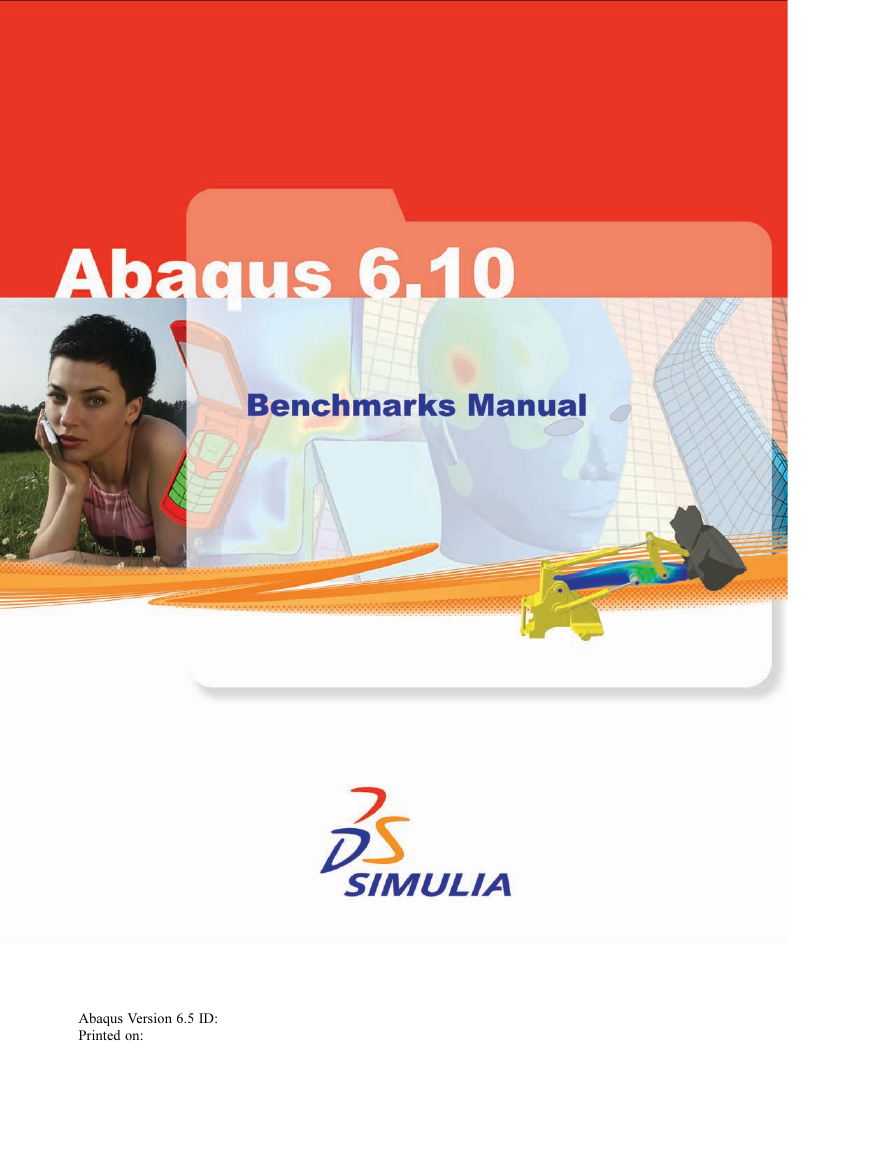

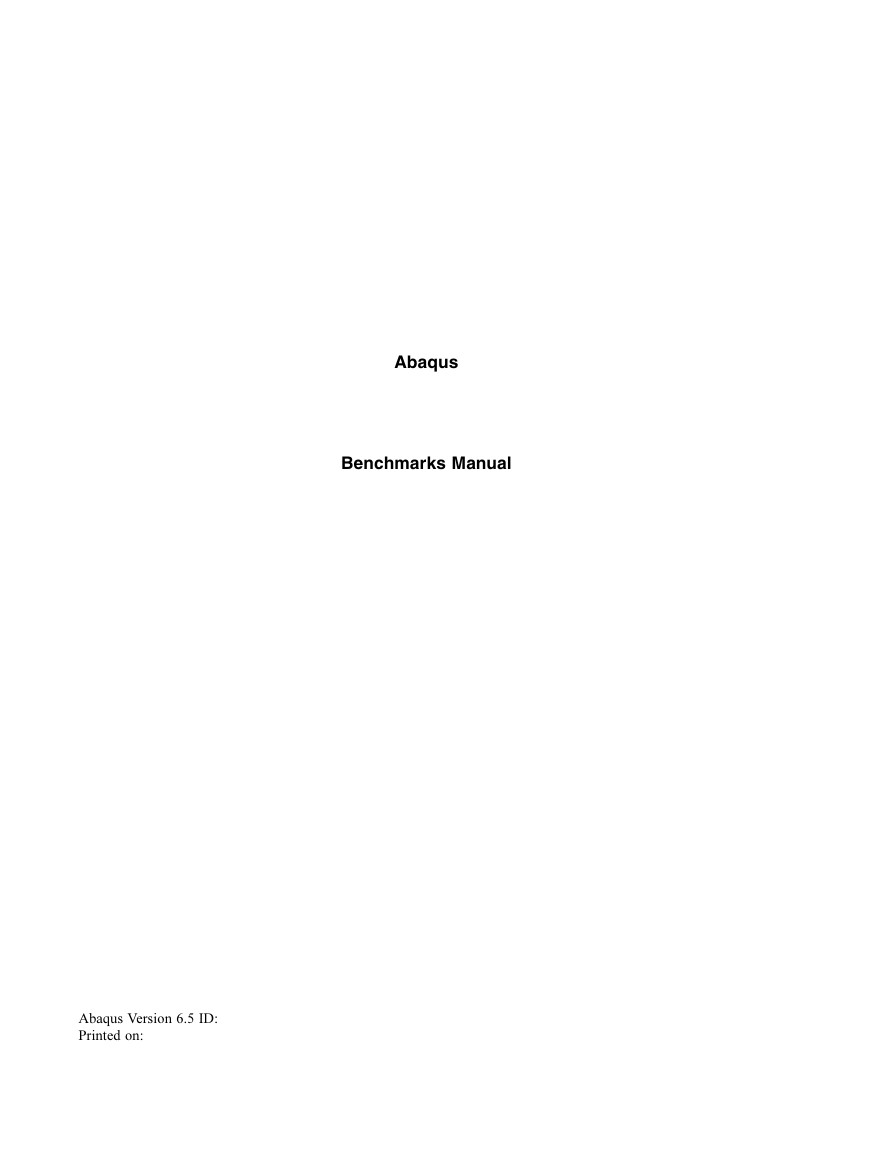
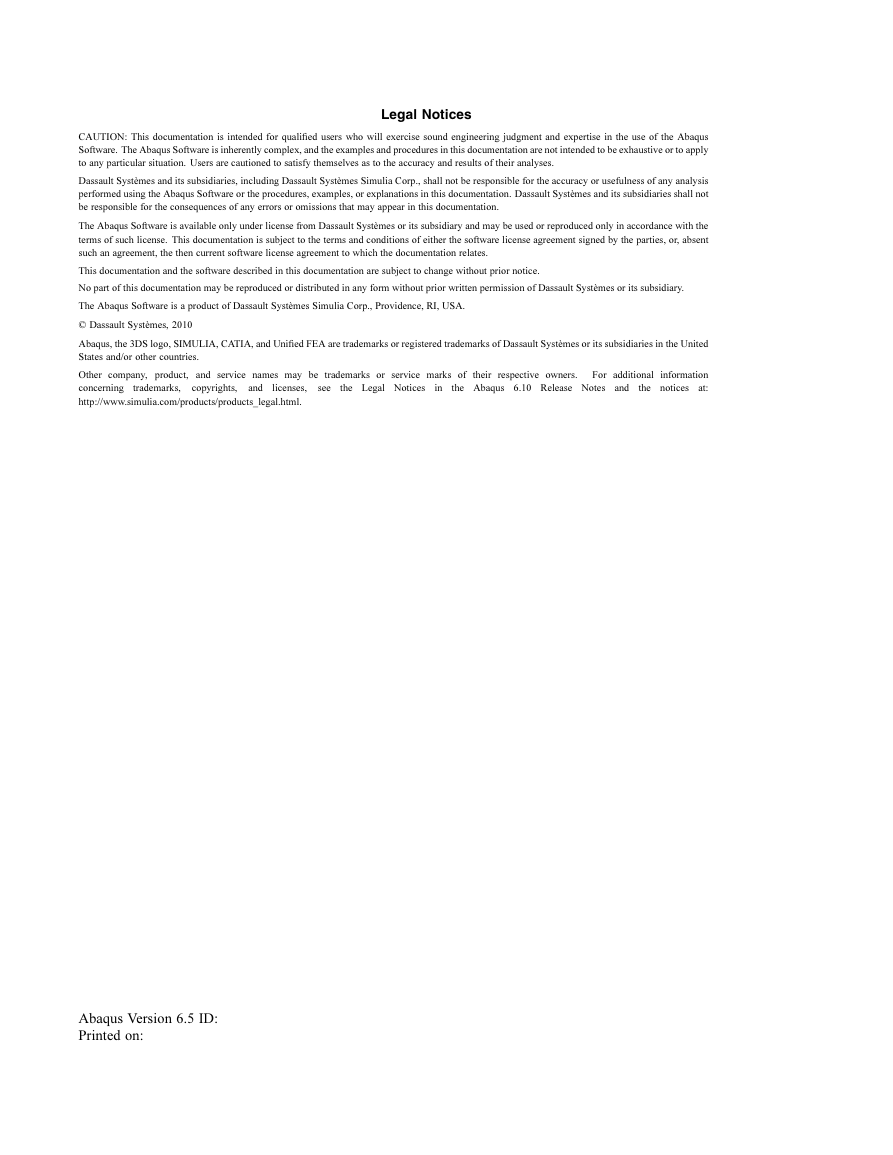
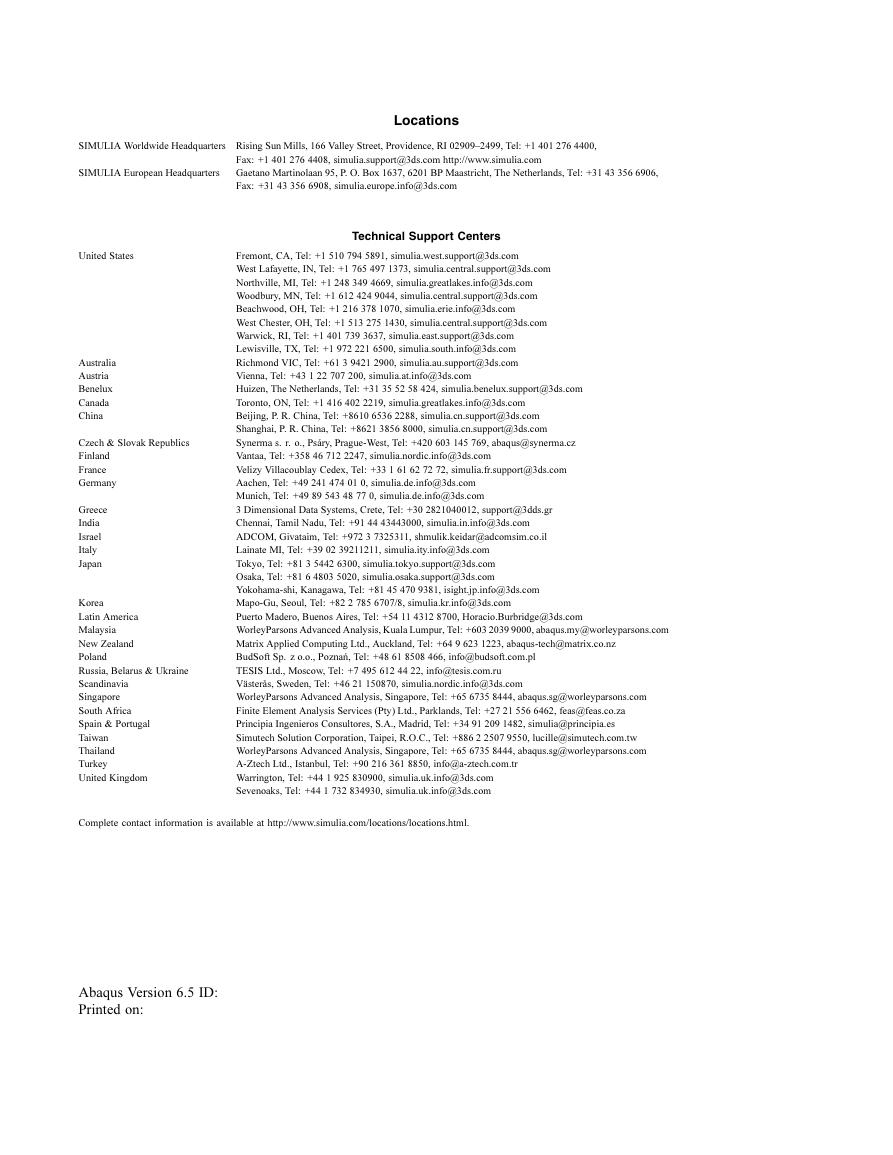

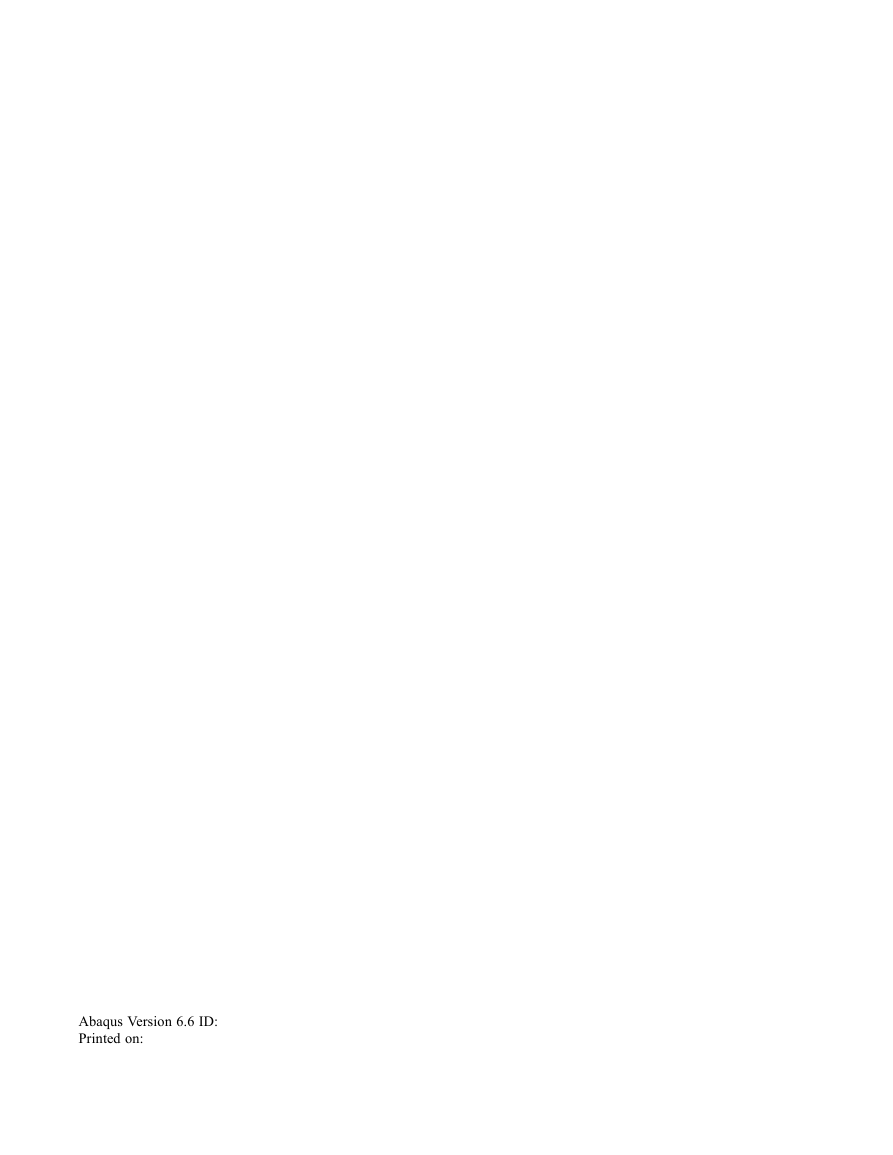
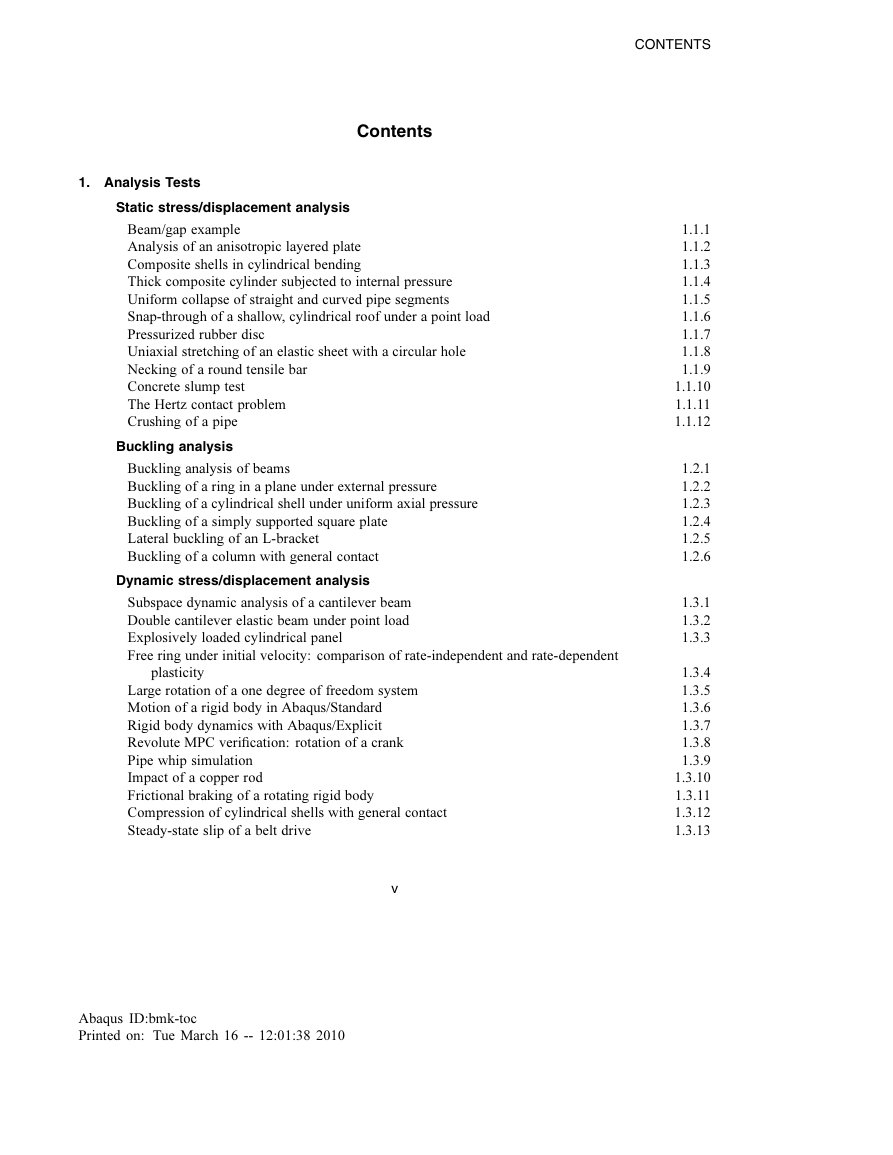








 2023年江西萍乡中考道德与法治真题及答案.doc
2023年江西萍乡中考道德与法治真题及答案.doc 2012年重庆南川中考生物真题及答案.doc
2012年重庆南川中考生物真题及答案.doc 2013年江西师范大学地理学综合及文艺理论基础考研真题.doc
2013年江西师范大学地理学综合及文艺理论基础考研真题.doc 2020年四川甘孜小升初语文真题及答案I卷.doc
2020年四川甘孜小升初语文真题及答案I卷.doc 2020年注册岩土工程师专业基础考试真题及答案.doc
2020年注册岩土工程师专业基础考试真题及答案.doc 2023-2024学年福建省厦门市九年级上学期数学月考试题及答案.doc
2023-2024学年福建省厦门市九年级上学期数学月考试题及答案.doc 2021-2022学年辽宁省沈阳市大东区九年级上学期语文期末试题及答案.doc
2021-2022学年辽宁省沈阳市大东区九年级上学期语文期末试题及答案.doc 2022-2023学年北京东城区初三第一学期物理期末试卷及答案.doc
2022-2023学年北京东城区初三第一学期物理期末试卷及答案.doc 2018上半年江西教师资格初中地理学科知识与教学能力真题及答案.doc
2018上半年江西教师资格初中地理学科知识与教学能力真题及答案.doc 2012年河北国家公务员申论考试真题及答案-省级.doc
2012年河北国家公务员申论考试真题及答案-省级.doc 2020-2021学年江苏省扬州市江都区邵樊片九年级上学期数学第一次质量检测试题及答案.doc
2020-2021学年江苏省扬州市江都区邵樊片九年级上学期数学第一次质量检测试题及答案.doc 2022下半年黑龙江教师资格证中学综合素质真题及答案.doc
2022下半年黑龙江教师资格证中学综合素质真题及答案.doc